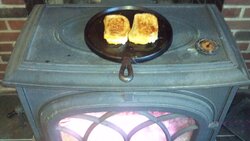Ok, I finally did it. 8 hr over night burn. Loaded to the gills and filled in cracks with small splits. E/W top to bottom. I burned from 11 pm to 7am reload. Stove top was still 250 and a great bad of coals left to start the morning fire. It took 40 min to get it from door close to air control shut down. This time I didn't check temps to determine when to adjust. Just flame. I made myself wait, it was not easy, thank goodness the fiesta bowl was on to distract me a bit. It was about 8-12 minutes for each 1/4 adjustment. I had to resist turning it down sooner while it was roaring, and also when it died out had to resist turning it back up. It came back strong. I had wild fantastic secondaries with air all the way down. Seemed like for an hour. Then went to bed. And house felt noticeably warmer than normal when the brats woke us. Anyway fellow rookies, it is possible! In my case more patience was the key.
Was all oak, and I think there were 8 splits in there. Only one real big piece. The stove takes 22" sticks, and theses puppies were all 21"
Was all oak, and I think there were 8 splits in there. Only one real big piece. The stove takes 22" sticks, and theses puppies were all 21"



